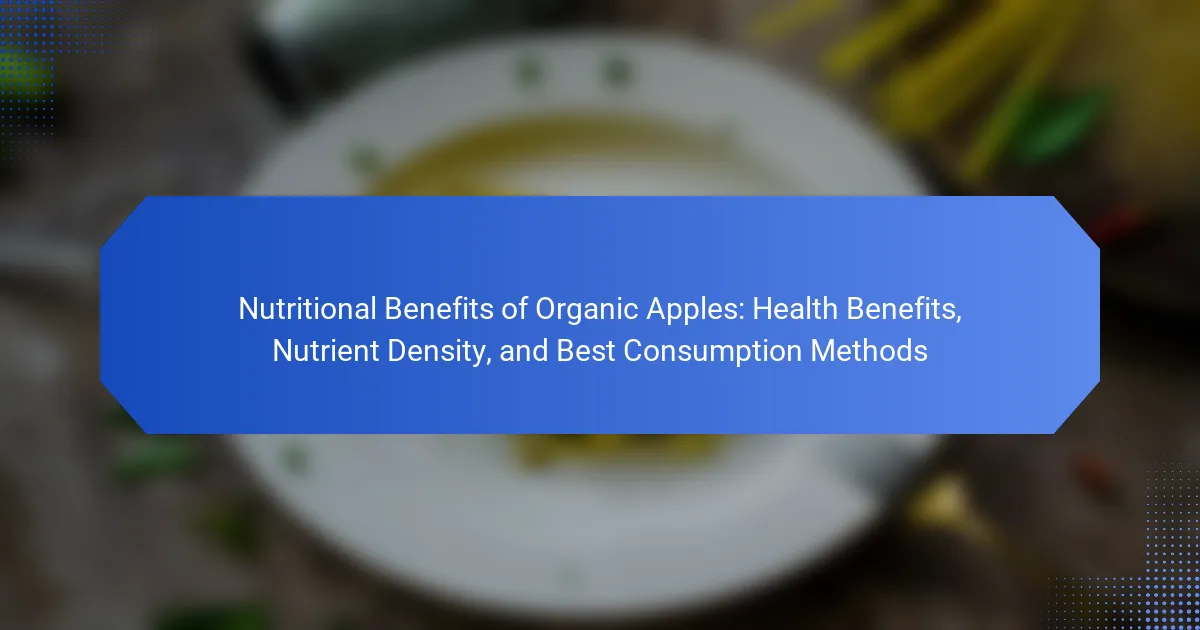Organic lentils are nutrient-dense legumes that provide significant health benefits, including high protein and dietary fiber content, essential vitamins and minerals. Each cooked cup contains approximately 18 grams of protein and 15.6 grams of fiber, supporting muscle growth, digestion, and cholesterol management. The article explores the nutritional advantages of organic lentils, such as their low glycemic index and antioxidant properties, which help regulate blood sugar and reduce inflammation. Additionally, it covers effective cooking techniques like soaking, sprouting, and simmering that enhance nutrient absorption, while addressing common misconceptions about organic lentils, including their nutritional equivalence to conventional varieties and availability in stores.

What are the Nutritional Benefits of Organic Lentils?
Organic lentils are nutrient-dense legumes that offer numerous health benefits. They are an excellent source of protein, providing about 18 grams per cooked cup. This high protein content supports muscle growth and repair. Organic lentils are also rich in dietary fiber, with approximately 15.6 grams per cooked cup. This fiber aids in digestion and helps maintain healthy cholesterol levels.
Additionally, organic lentils are low in fat and contain essential vitamins and minerals. They provide significant amounts of folate, iron, and magnesium. Folate is crucial for cell division and DNA synthesis. Iron is vital for oxygen transport in the blood, while magnesium supports various biochemical reactions in the body.
Moreover, organic lentils have a low glycemic index. This means they can help regulate blood sugar levels. Their antioxidant properties may also contribute to reducing inflammation.
In summary, the nutritional benefits of organic lentils include high protein and fiber content, essential vitamins and minerals, and positive effects on blood sugar regulation and inflammation.
How do Organic Lentils compare to other legumes?
Organic lentils offer a higher protein content compared to many other legumes. They typically contain around 18 grams of protein per cooked cup. In contrast, beans like kidney or black beans have approximately 15 grams. Organic lentils also provide more fiber, with about 15 grams per cooked cup, while chickpeas offer around 12 grams. Nutritionally, organic lentils are lower in fat, making them a healthier option. They are also rich in iron, with about 3.3 mg per cooked cup, which is higher than many other legumes. This nutritional profile makes organic lentils a versatile and beneficial choice in a balanced diet.
What unique nutrients do Organic Lentils provide?
Organic lentils provide unique nutrients such as folate, iron, and magnesium. Folate is essential for DNA synthesis and repair. A one-cup serving of cooked organic lentils contains approximately 90% of the daily recommended intake of folate. Iron is crucial for oxygen transport in the blood. Organic lentils offer about 37% of the daily value of iron per cup. Magnesium supports muscle and nerve function. A cup of cooked organic lentils provides around 18% of the daily value of magnesium. These nutrients contribute to the overall health benefits of incorporating organic lentils into the diet.
Why are Organic Lentils considered a superfood?
Organic lentils are considered a superfood due to their high nutritional value. They are rich in protein, providing about 18 grams per cooked cup. Organic lentils also contain significant amounts of dietary fiber, with around 15.6 grams per cup. This fiber aids in digestion and promotes a feeling of fullness. Additionally, they are low in fat and calories, making them a healthy choice. Organic lentils are packed with essential vitamins and minerals, including iron, folate, and magnesium. These nutrients support overall health and help prevent chronic diseases. Studies have shown that regular consumption of lentils can improve heart health and stabilize blood sugar levels.
What role does Protein play in Organic Lentils?
Protein in organic lentils serves as a vital nutrient for muscle building and repair. Organic lentils contain approximately 18 grams of protein per cooked cup. This makes them an excellent plant-based protein source. The protein in lentils is composed of essential amino acids, which are crucial for various bodily functions. Consuming lentils can help meet daily protein requirements, especially for vegetarians and vegans. Additionally, the protein content contributes to satiety, aiding in weight management. Studies indicate that incorporating lentils into the diet can support overall health by providing necessary nutrients and promoting muscle health.
How much protein is found in Organic Lentils?
Organic lentils contain approximately 18 grams of protein per cooked cup. This high protein content makes them a valuable plant-based protein source. Lentils are also rich in essential amino acids. They provide a complete protein profile when combined with grains. This nutritional value supports muscle health and overall wellness. Studies confirm that incorporating lentils into the diet enhances protein intake.
What are the benefits of plant-based protein from Organic Lentils?
Plant-based protein from organic lentils offers numerous health benefits. It is a complete protein source, containing all essential amino acids. This makes it an excellent alternative to animal proteins. Organic lentils are also high in fiber, promoting digestive health and aiding in weight management. Additionally, they have a low glycemic index, which helps regulate blood sugar levels. Rich in vitamins and minerals, they provide nutrients such as iron, magnesium, and folate. Studies show that consuming plant-based proteins can lower the risk of chronic diseases, including heart disease and diabetes. Therefore, incorporating organic lentils into the diet can contribute to overall health and wellness.
How does Fiber in Organic Lentils contribute to health?
Fiber in organic lentils contributes to health by promoting digestive health and aiding in weight management. It helps maintain regular bowel movements by adding bulk to the stool. This can prevent constipation and improve overall gut health.
Additionally, fiber in lentils can help regulate blood sugar levels. It slows down the absorption of sugar, which can reduce spikes in blood glucose. This is particularly beneficial for individuals with diabetes.
Furthermore, fiber contributes to a feeling of fullness, which can aid in weight loss efforts. Studies show that high-fiber diets are associated with lower body weight.
Organic lentils are rich in soluble fiber, which can help lower cholesterol levels. This can reduce the risk of heart disease. Overall, the fiber content in organic lentils plays a crucial role in supporting various aspects of health.
What types of fiber are present in Organic Lentils?
Organic lentils contain both soluble and insoluble fiber. Soluble fiber helps regulate blood sugar levels and lowers cholesterol. Insoluble fiber aids in digestion and promotes bowel regularity. The presence of these fibers contributes to overall health benefits. Studies indicate that a diet high in fiber can reduce the risk of chronic diseases. Organic lentils provide approximately 7.9 grams of fiber per 100 grams. This makes them an excellent source of dietary fiber.
How does fiber from Organic Lentils support digestion?
Fiber from organic lentils supports digestion by promoting regular bowel movements. This type of fiber adds bulk to stool, making it easier to pass. Additionally, fiber helps to prevent constipation. It also aids in maintaining a healthy gut microbiome. The soluble fiber in lentils can slow digestion, which helps regulate blood sugar levels. Studies show that dietary fiber intake is linked to reduced gastrointestinal issues. For example, a review published in the Journal of Nutrition highlights the benefits of fiber-rich foods like lentils for digestive health. Thus, the fiber in organic lentils plays a crucial role in enhancing digestive function.

What Cooking Techniques Enhance the Benefits of Organic Lentils?
Soaking, sprouting, and simmering enhance the benefits of organic lentils. Soaking lentils for several hours reduces cooking time and improves digestibility. Sprouting lentils increases their nutritional profile, enhancing vitamin content and bioavailability. Simmering lentils gently preserves their nutrients while making them tender. These techniques collectively maximize protein and fiber absorption. Research indicates that soaking can reduce anti-nutrients, making nutrients more accessible. Sprouted lentils have been shown to contain higher levels of essential amino acids.
How can you prepare Organic Lentils for maximum nutrition?
Soaking organic lentils before cooking enhances their nutritional value. Soaking reduces cooking time and increases digestibility. It also helps to deactivate antinutrients like phytic acid. Rinsing lentils after soaking can further improve nutrient absorption. Cooking lentils in low-sodium broth adds flavor without excessive salt. Using a pressure cooker retains more nutrients compared to boiling. Adding vegetables during cooking increases fiber and vitamin content. Finally, consuming lentils with a source of vitamin C enhances iron absorption.
What are the best cooking methods for Organic Lentils?
The best cooking methods for organic lentils include boiling, steaming, and sautéing. Boiling is the most common method. It typically takes 15 to 20 minutes for lentils to cook in boiling water. Steaming preserves more nutrients compared to boiling. This method can take about 20 to 25 minutes. Sautéing lentils with vegetables enhances flavor and can be done in about 10 minutes after pre-cooking. Each method allows lentils to retain their protein and fiber content effectively.
How does soaking Organic Lentils affect their nutritional profile?
Soaking organic lentils enhances their nutritional profile by increasing nutrient availability and reducing anti-nutrients. The soaking process activates enzymes that break down complex sugars. This leads to improved digestibility and absorption of nutrients. Additionally, soaking can decrease the levels of phytic acid, which inhibits mineral absorption. Research indicates that soaking can increase the levels of certain vitamins, such as B vitamins. A study published in the Journal of Food Science found that soaking lentils significantly increases the bioavailability of iron and zinc. Overall, soaking organic lentils makes them a more nutritious food option.
What recipes can showcase the benefits of Organic Lentils?
Organic lentils can be showcased in various recipes that highlight their nutritional benefits. Lentil soup is a popular choice, providing protein and fiber. A lentil salad with fresh vegetables enhances nutrient intake. Lentil curry offers a rich source of protein while being flavorful. Additionally, lentil burgers serve as a high-fiber, plant-based protein alternative. Each of these recipes emphasizes the health benefits of organic lentils, making them versatile for different dietary needs.
Which dishes highlight the protein content of Organic Lentils?
Organic lentils are featured in various dishes that emphasize their high protein content. Lentil soup is a popular choice, providing a hearty meal packed with protein. Lentil salad combines fresh vegetables and herbs, showcasing the lentils’ nutritional benefits. Lentil curry offers a flavorful option, rich in protein and spices. Additionally, lentil burgers serve as a plant-based protein alternative in sandwiches. Each of these dishes highlights the protein-rich nature of organic lentils, making them a valuable ingredient in a balanced diet.
How can you incorporate Organic Lentils into a balanced diet?
Incorporating organic lentils into a balanced diet can be achieved through various methods. Start by adding cooked lentils to salads for added protein and fiber. Use lentils as a meat substitute in dishes like tacos or burgers. Incorporate lentils into soups and stews for a hearty texture and nutritional boost. Prepare lentil-based dips, such as lentil hummus, for a healthy snack option. Use lentils in grain bowls alongside vegetables and healthy fats. The high protein content of lentils supports muscle health, while their fiber aids digestion. Studies show that lentils can improve overall diet quality due to their nutrient density.

What are Common Misconceptions About Organic Lentils?
Common misconceptions about organic lentils include the belief that they are significantly more nutritious than conventional lentils. While organic lentils may have fewer pesticide residues, their nutritional profile is similar to that of non-organic lentils. Another misconception is that organic lentils are always more expensive. The price can vary based on factors like brand and location, not solely on organic certification. Some people think organic lentils require special cooking methods. In reality, they can be cooked like any other lentils. Additionally, there is a belief that organic lentils are less available than conventional ones. In fact, organic lentils are increasingly found in mainstream grocery stores. Finally, many assume that all organic lentils are grown sustainably. However, organic certification does not guarantee sustainable farming practices.
Why do some people avoid Organic Lentils?
Some people avoid organic lentils due to concerns about cost. Organic lentils typically have a higher price point compared to conventional lentils. This price difference can deter budget-conscious consumers. Additionally, some individuals may be wary of the taste or texture of organic lentils. They might find them less appealing than their non-organic counterparts. Others might avoid organic lentils due to perceived availability issues. Organic products can sometimes be harder to find in certain grocery stores. Lastly, there are individuals who may not prioritize organic foods. They may not believe in the benefits of organic over conventional options.
What are the myths surrounding the digestibility of Organic Lentils?
One common myth is that organic lentils are hard to digest. This belief stems from the presence of anti-nutrients like phytic acid. However, cooking methods such as soaking and boiling significantly reduce these compounds. Studies show that properly prepared lentils are easily digestible for most people. Another myth suggests that lentils cause excessive gas. While lentils can produce gas, gradual introduction into the diet helps the body adjust. Research indicates that lentils can be part of a balanced diet without causing discomfort when consumed appropriately. Overall, misconceptions about organic lentils’ digestibility are largely unfounded.
How can you address concerns about gas from lentils?
To address concerns about gas from lentils, proper preparation methods are essential. Soaking lentils before cooking can significantly reduce gas production. This process helps to break down oligosaccharides, the compounds that cause gas. Rinsing soaked lentils can further eliminate these compounds. Cooking lentils thoroughly also aids in digestion, making them easier on the stomach. Adding spices like cumin or ginger during cooking can enhance digestion and reduce gas. Studies show that these methods can lead to a more comfortable digestive experience with lentils.
What practical tips can enhance your experience with Organic Lentils?
Soaking organic lentils before cooking reduces cooking time and enhances digestibility. This process helps to break down complex sugars that can cause gas. Rinse the lentils thoroughly to remove any debris or impurities. Cooking lentils in vegetable or chicken broth adds flavor compared to water. Incorporating spices like cumin or turmeric can enhance taste and provide additional health benefits. Adding acidic ingredients, such as tomatoes or vinegar, after lentils are cooked helps maintain their texture. Pairing lentils with whole grains, like brown rice, increases the protein quality. Lastly, store cooked lentils in the refrigerator for up to a week for convenient meal prep.
How can you store Organic Lentils for longevity?
Store organic lentils in a cool, dry place to ensure longevity. Use airtight containers to protect them from moisture and pests. Glass jars, plastic bins, or vacuum-sealed bags are effective storage options. Keep lentils away from direct sunlight and heat sources. Properly stored, organic lentils can last for up to two years. Regularly check for any signs of spoilage, such as off smells or discoloration. This method helps maintain their nutritional quality and flavor over time.
What are the best practices for cooking Organic Lentils to retain nutrients?
To retain nutrients in organic lentils, use minimal cooking time and avoid high heat. Cooking lentils for 15-20 minutes is sufficient. Soaking lentils for a few hours before cooking can reduce cooking time and enhance nutrient absorption. Use just enough water to cover the lentils, as excess water can leach nutrients. Steaming is preferable over boiling, as it helps preserve vitamins. Adding acidic ingredients like tomatoes or vinegar should be done after cooking to prevent nutrient loss. These practices help maintain the high protein and fiber content of organic lentils.
Organic lentils are nutrient-dense legumes known for their high protein and fiber content, providing approximately 18 grams of protein and 15.6 grams of fiber per cooked cup. This article explores the nutritional benefits of organic lentils, including their essential vitamins and minerals such as folate, iron, and magnesium, as well as their role in blood sugar regulation and digestive health. It also compares organic lentils to other legumes, highlights unique nutrients, and discusses effective cooking techniques that enhance their nutritional profile. Additionally, common misconceptions and practical tips for incorporating organic lentils into a balanced diet are addressed.



